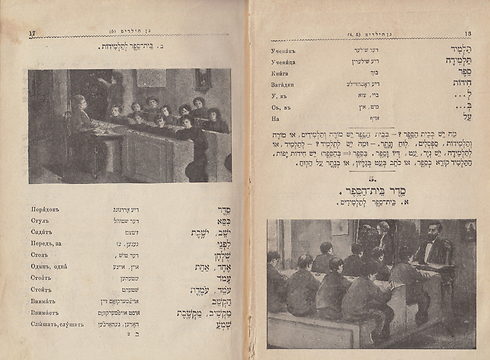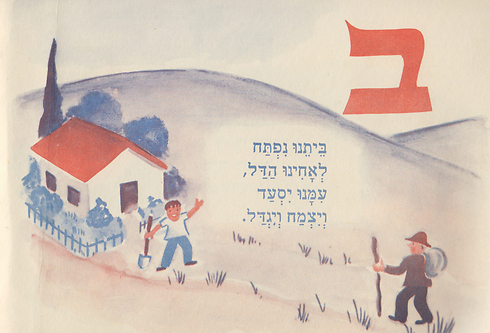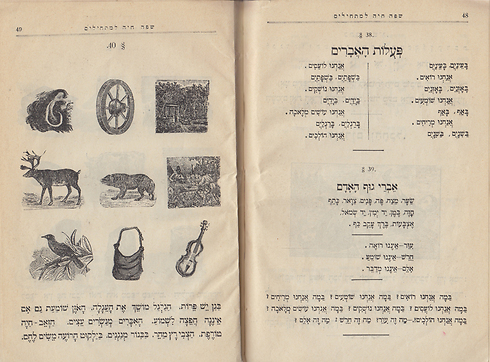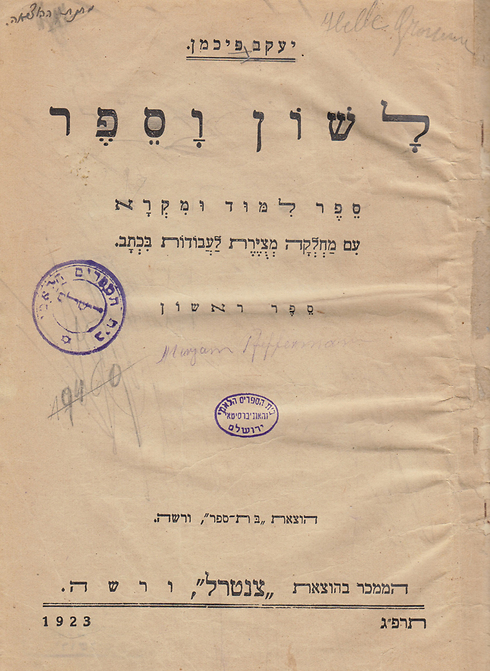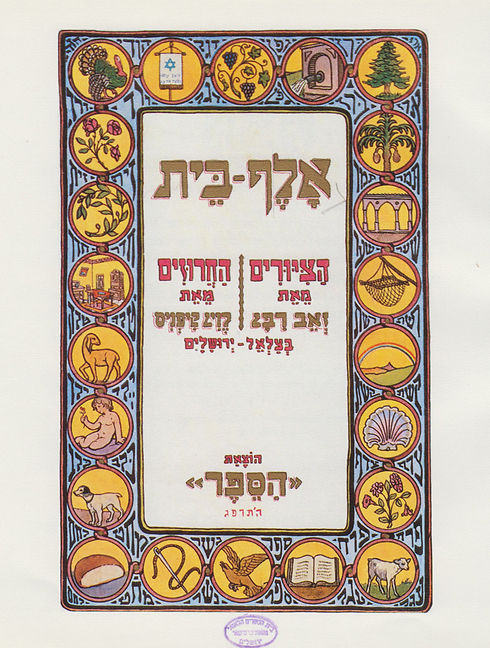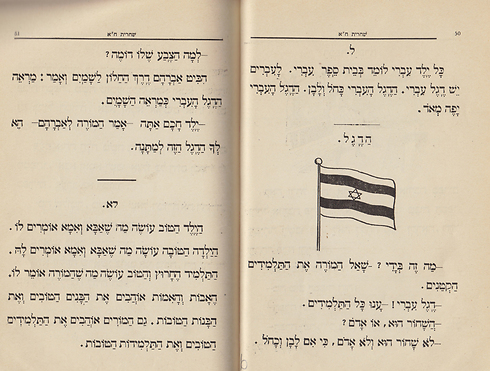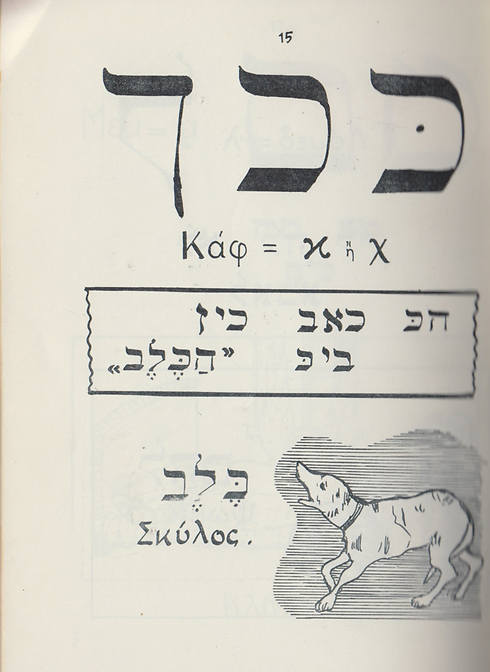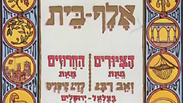
How to learn Hebrew - 100 years ago
As new school year opens, National Library focuses on mid-19th and early 20th century Hebrew learning textbooks that imparted Zionist ideology and served as a pioneer for Hebrew literature in general.
In honor of the new school year, the National Library has pulled out the cellar textbooks from more than 100 years ago, which shed light on early Jewish education in Israel and the Diaspora.
These are books which were published in the late 19th and early 20th century in order to teach children to read and write Hebrew in a lively manner, to connect them to the Jewish people and especially to revive the Hebrew language.
Kindergarten, Shlomo Berman, 1900, Ukraine, 198 pages
This was a reading book for children aged six to eight with many drawings. Berman started writing in the Ukraine in the mid-19th century, and wanted this book to suit his young pupils. The drawings illustrate classroom life, and the child's world at home and outdoors. As such they serve as a direct source illustrating the nature of the Jewish educational framework at that time.
The book is rife with European children's texts translated into Hebrew, and this demonstrates the considerable effort devoted to establishing as quickly as possible a rich cultural world to be given students of Hebrew as a replacement for the wealth of children's literature in Yiddish. Thus, children's literature in Hebrew was a pioneer of Hebrew literature in general.
A Living Language for Beginners, by Z. Or, Y. Zilberhertz, Ukraine , 1907, 80 pages
This book contains only Hebrew, with no translations into other languages, and it is clear that it was written for children who already knew how to read Hebrew from a prayer book or the Bible. The authors were part of the "improved cheder" (the cheder was the traditional Jewish elementary school) - the effort to enrich the cheder's curriculum to include secular subjects such as world history and history of the Jewish people, and especially the study of Hebrew subjects in Hebrew as opposed to studying them in Yiddish.
The book refers to the square Hebrew script and the round cursive Hebrew script as well, so that the children would be able to use Hebrew in a day to day context, as the cursive was the script most often used in writing.
A Living Language for Children , author unknown, 1915. London, 97 pages
This book represents the development of Hebrew education in an established network of schools. On the inside book cover the publisher offers up for sale Hebrew tablets to hang up in the classroom. The English name of the book - Sofo Chayo Layeladim - indicates the Ashkenazi pronunciation that was the norm even in new institutions teaching Hebrew.
The Sephardic accent which is used today took root later on, especially in the Land of Israel. At the end of the book, published in London, appendices were printed including key words translated into Yiddish and English, as well an appendix on learning Rashi script.
The Student's Book, from Steve Saperstein, 1918. New York, 124 pages
This book was intended for the children of Jewish immigrants to America who had arrived in the country before the First World War. The illustrations tell the story of the Jewish community during that time and point to learning procedures, such as the strict uniforms worn by students and teachers or classroom seating arrangements.
Children can be seen playing with an Israeli flag (the flag of the Zionist movement at the time - only one year after the Balfour Declaration to establish a Jewish home in the Land of Israel), and a map of Israel hanging on the classroom wall. The houses are large structures in the suburbs, the furniture is typically American, and the children are playing baseball. The book also contains music scores of Jewish children songs.
Language and Book. By Yakov Fichman 1923. Warsaw, 158 pages
This book was published in Warsaw, the main Jewish town in Eastern Europe, which served as the capital of Jewish culture in the period between the two world wars until the Holocaust. All the literature and songs speak of the purity of modern Hebrew literature.
The book contains work of the greatest Hebrew writers such as Bialik and Tchernichovsky, with the aim of creating as broad and rich of a Hebrew culture for children as possible which could provide the basis for the development of Hebrew culture as a whole for generations to come.
To enable children to overcome the difficulty of the high level of language, a vocabulary of difficult words was printed on the margins of each piece. The high level of this publication demonstrates the flowering of Hebrew publishing in the first half of the 1920s. The illustrations are artistic and are printed in high quality.
Aleph Bet. Levin Kipnis and Ze'ev Raban, Berlin, 1923
Children's writer Levin Kipnis wrote the verses, the artist Ze'ev Raban, who was one of the founders of Bezalel, drew the letters and images, and publishing house "Hasefer" printed the book at the highest level of quality. The book was intended for children of the European Jewish education system, and apart from its careful aesthetic aspect, the writers who lived in the Land of Israel filled it with Zionistic messages of making aliyah.
It is considered one of the high points of early Hebrew publishing, and was even reprinted by Modan Publishing in 1985.
Shacharit. By Menachem Mendel Tomarov, Binyamin Hirsch, and Shachna Stein, Brooklyn, 1924. 112 pages
According to the authors at the book's opening, they seek to influence the development of Jewish education in the United States whose nature had yet to be formulated. "One of the biggest hindrances is the lack of learning and education books that suit the prevailing conditions of life in this country. Our lives in the new country are very different from the lives of our brothers in Russia, for whom almost all of the textbooks were written for."
The book is designed to deal with the situation in which very few hours were devoted to the study of Hebrew, and to give teachers and students easier, more refreshing and accessible learning material, progressing from easy to more difficult. To this end, almost all the reading passages were written especially for the book. Apart from the illustrations in the book , there were also photographs. This book is also Zionistic and the Zionist flag, Herzl's picture and a map of Israel are included.
Alep Bet for the Children of Israel by Rabbi Shabati. Thessaloniki, 1954. 54 pages
This little book was printed for the remnants of the Jewish community of Thessaloniki which was almost completely wiped out in the Holocaust, and the modest amount of published books reveals that.
Everything is handwritten, and the Hebrew letters are accompanied by the corresponding letters of the Greek language and Ladino, the traditional spoken language of the Jews of Greece. Ladino was also written in Hebrew letters.
The book was intended for traditional education, and it seems that it was used to study religious subjects. Like other books of this kind, the book follows the cycle of the Jewish year - Shabbat and the holidays – and the synagogue










